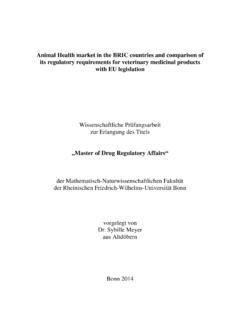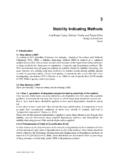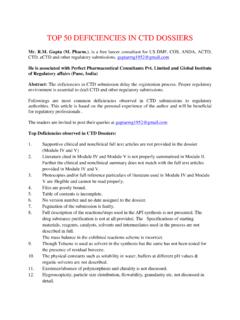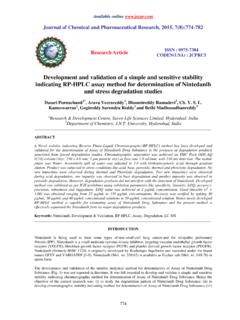Transcription of Forced degradation studies – comparison between …
1 Forced degradation studies comparison between ICH, EMA, FDA and WHO guidelines and ANVISA s resolution RDC 53/2015 Wissenschaftliche Pr fungsarbeit zur Erlangung des Titels Master of Drug Regulatory Affairs der Mathematisch-Naturwissenschaftlichen Fakult t der Rheinischen Friedrich-Wilhelms -Universit t Bonn vorgelegt von Helene Janzen aus Susanowo Bonn 2016 Page I Betreuer und 1. Referent: Prof. Dr. Usfeya Muazzam 2. Referent: Dr. Christin Selent-Stier Page II Table of Contents List of Figures .. IV List of Abbreviations .. V 1. Introduction and scope .. 1 2. Forced degradation studies .. 2 Terms for Forced 2 Purpose of Forced degradation 2 3. Regulatory overview .. 4 ICH guidelines - regulatory overview .. 4 ICH Q1A Stability Testing of New Drug Substances and Products .. 5 ICH Q1B Photostability Testing of New Drug Substances and Drug Products.
2 6 ICH Q2B Validation of Analytical Procedures: Methodology .. 7 ICH Q3A Impurities in New Drug Substances/ ICH Q3B Impurities in New Products .. 8 M4Q(R1) The Common Technical Document for the Registration of Pharmaceuticals for Human Use: Module 3: Quality .. 8 EMA guidelines - regulatory overview .. 9 FDA guidelines - regulatory overview .. 10 Pharmacopoeia requirements- regulatory overview .. 12 USP Pharmacopoeia .. 12 JP Pharmacopoeia .. 12 World Health Organization .. 12 Typical stress test conditions for Forced degradation studies .. 15 Thermal stress tests - dry heat and wet heat .. 16 Photolytic degradation .. 16 Hydrolytic degradation .. 17 Oxidation degradation .. 17 Current view on limits for Forced degradation .. 18 Analytical methods for identification of degradation products .. 18 Time point for performing Forced degradation studies .
3 20 ANVISA regulatory overview .. 21 Background and history on the ANVISA legal requirements regarding stability and Forced degradation .. 21 General remarks to applicability and timelines of ANVISA s resolution RDC 53/2015 .. 23 comparison between resolution RDC 53/2015 and ICH guidelines and critical assessment .. 24 4. Discussion .. 35 5. Outlook .. 36 degradation profile protocol .. 37 Purpose of degradation study .. 37 Information on the structural formula .. 38 Analytical procedure .. 38 Overview of the performed studies .. 38 Results of the studies .. 39 Evaluation and conclusion of the degradation studies .. 40 6. Conclusions .. 42 Page III 7. Summary .. 43 References .. 45 Page IV List of Tables Table 1: Definitions for Forced degradation testing and confirmatory 6 Table 2: Typical stress conditions in pre-formulation stability studies [30].
4 14 Table 3: Adopted RDC 53/2015 versus ICH definitions [1, 5, 7, 15, 16, 58] .. 25 Table 4: Thresholds for degradation products according to resolution RDC 53/ 2015 .. 33 Table 5: Thresholds for degradation products according to ICH Q3B .. 34 Table 6: Structural and molecular formula, chemical name of drug substance/ characterized impurities .. 38 Table 7: Stress conditions .. 39 Table 8: Assay and degradation profile at 70 C in Fe2+ and Cu2+ solution .. 40 List of Figures Figure 1: Importance of Forced degradation in pharmaceuticals .. 4 Figure 2: General stress conditions used for drug substances and drug products for degradation studies [32] .. 15 Figure 3: Timing for performing Forced degradation studies .. 21 Figure 4: Development on ANVISA S Forced degradation legislative .. 22 Page V List of Abbreviations ANVISA National Health Surveillance Agency (in Portuguese Ag ncia Nacional de Vigil ncia Sanit ria) Art.
5 Article API Active Pharmaceutical Ingredient ATD Average Daily Dosage CGMP Current Good Manufacturing Practices CP Public Consultation (in Portuguese Consulta P blica) CTD Common Technical Document DMF Drug Master File EMA European Medicines Agency FDA Food and Drug Administration, USA FDC Fixed-Dose Combination FPP Finished Pharmaceutical Product HPLC High Performance Liquid Chromatography ICH International Conference on Harmonization IND Investigational New Drug Application JP Japanese Pharmacopoeia LoD Limit of Detection LoQ Limit of Quantification PDA Photodiode Detector Array QOS-PD Quality Overall Summary - Product Dossiers RDC Board Resolution Collegiate (in Portuguese Resolu o de Diretoria Colegiada) RRF Relative Response Factor RRT Relative Retention Time RH Relative Humidity RT Room Temperature USP US Pharmacopoeia UV Ultraviolet WHO World Health Organization EPAR European Public Assessment Report WHOPAR World Health Organization Public Assessment Report Page 1 1.
6 Introduction and scope Forced degradation is an exposure of the drug substance or drug product to different stress conditions (more severe than accelerated conditions) [1] which results in relevant degradation products. Purposefully used Forced degradation is a useful tool in predicting drug stability. The drug stability is a critical parameter and has an impact on purity, potency, and safety of the drug product. For instance, changes in drug stability can result in lower doses or toxic degradation products. Therefore it is fundamental to know the behavior and the purity profile of a drug under various conditions [2]. Currently several guidelines provide recommendations and guidance on Forced degradation studies , but none of the guidelines gives detailed, complete and clear instructions or definitions regarding the individual aspects exact conditions or exposure times.
7 This leads to uncertainty and disagreement between the pharmaceutical companies resulting in different approaches when conducting Forced degradation studies . In the past years one of the national regulatory agencies - the Brazilian National Health Surveillance Agency (ANVISA) - has dedicated themselves to deal with the topic Forced degradation . ANVISA has taken over a pioneering task in establishing further requirements and guidance in comparison to what is currently available. In 2013 ANVISA published resolution RDC 58/2013 and introduced new standards for reporting, identification and qualification of degradation products in drug products [3]. To enable the companies to comply with the new requirements ANVISA additionally issued a degradation products guide, the revised document CP 68 [4]. The guide is intended to promote the views of ANVISA regarding the degradation profile and the testing procedures for the identification and qualification of degradation products.
8 According to the deadline for the Collegiate Board Resolution (RDC), the resolution RDC 58/2013 was expected to come into force end of December 2015. But on December 4th 2015 ANVISA revoked RDC 58/2013 and published instead an updated version of this resolution: Resolution RDC 53/2015 [5]. Resolution RDC 53/2015 includes updated standards on different aspects and topics of Forced degradation to which the pharmaceutical companies have to comply. For all new concentration or new dosage form inclusions the new resolution became valid on December 23, 2015. For medicines which are already registered in Brazil the resolution RDC 53/2015 includes different timeliness for the implementation. Page 2 The aim of this master thesis is: To provide a general overview on the topic Forced degradation and on the current available regulatory guidance (ICH including EMA, FDA and WHO) To give an overview on the requirements of resolution RDC 53/2015 and provide a comparison between the new standards laid down in ANVISA s resolution RDC 53/2015 and the currently available regulatory standards To start a discussion on the differences and similarities as well as the challenges and critical points for the pharmaceutical companies to meet the new requirements To discuss the content of a protocol describing the degradation profile for products, which is requested by ANVISA to be provided by the pharmaceutical companies in the content of this resolution 2.
9 Forced degradation studies Terms for Forced degradation Internationally different terms are used for the description of Forced degradation . Even within the ICH guidelines more than one term for the description of Forced degradation is used ICH Q1A [1] uses the term stress testing , while ICH Q1B [7] uses the term Forced decomposition . Purpose of Forced degradation testing According to the ICH guideline Q1A, section the purpose of stress testing for the new drug substances is as follows [1]: Stress testing of the drug substance can help identify the likely degradation products, which can in turn help establish the degradation pathways and the intrinsic stability of the molecule and validate the stability indicating power of the analytical procedures used. The nature of the stress testing will depend on the individual drug substance and the type of drug product involved.
10 In summary, from the regulatory perspective, Forced degradations studies are performed [1]: Page 3 To identify possible degradation products To establish degradation pathways and intrinsic stability of the drug molecule To validate stability-indicating analytical procedures When looking beyond ICH guidelines and looking into the literature and the current trends for Forced degradation studies , the initial purpose of Forced degradation studies is to understand drug molecule chemistry [8], to investigate stability-related properties of an API and to develop an understanding of the degradation products and pathways [9]. In following a selection of purposes for performing Forced degradation studies is listed [2, 8, 9, 10, 11, 12]: to elucidate the structure of the degradation products to develop and validate a stability-indicating analytical method to identify impurities related to drug substances or excipients to generate more stable formulations to distinguish degradation products in formulations that are related to drug substances from those that are related to non-drug substances ( , excipients) to solve stability-related problems ( , mass balance)















